The practicality of pontoons
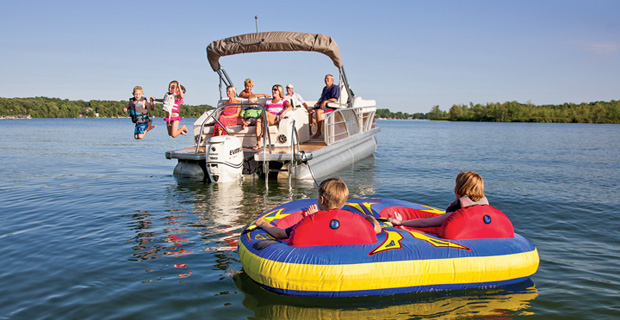
With increased performance, contemporary styling and economical entry-level options, the pontoon is one of the fastest growing segments in boating – and for good reason.
For the boating industry as a whole, 2012 was a good year with boat sales increasing by double digits. For pontoons, it was a fantastic year as fans of the segment grew considerably, driving a 21-percent increase in sales, according to RBC Capital Markets.
Very little negative sentiment still exists for the segment, while current and prospective pontoon owners laud its practicality, affordability and performance.
Those qualities have broadened the target demographic from grandparents taking their grandchildren on the water to the first boating introduction of young families across North America.
“Years ago, the 30-something couple would tell you they aren’t old enough for a pontoon yet; it was their grandfather’s boat,” Bob Wachs, product manager for Godfrey Pontoons, said. “Now they walk onto the boat and immediately ask if they can get a ski bar on it and pull their kids skiing.”
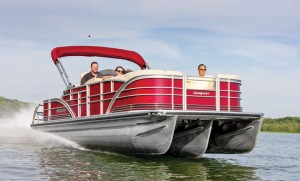
And they can. Innovations like hulls with three tubes featuring larger diameters that allow for faster and smoother cruising have catapulted pontoons to the forefront of boaters who want to entertain, cruise, water ski or dock their boat. The capability is an addition to the unparalleled capacity the segment’s fans have long grown accustomed to.
It is no longer an anomaly to see a 300-horsepower engine on a pontoon. The increased versatility has made it a popular entry-level model for those who do not want to give up water sports, but also want to entertain their own growing family and friends.
Tom Menne, vice president of Weeres Pontoons and Palm Beach Pontoons, said this evolution has picked up over the last few years. Those in the past often evolved into pontoons as they grew older or their families grew in number. Today, according to Menne, that customer is starting with a pontoon, especially as they are seeing more examples of the segment’s versatility on the water.
“The driving force [of this growth] is the water sports behind the pontoon like tubing or just going out and anchoring and swimming. It is a boat that is for anyone who wants to play in or on the water,” Menne said.
Affordability is also driving momentum for pontoons, according to Wachs, who said a triple-tube pontoon capable of speeds up to 40 miles per hour and a trailer can be purchased for less than $30,000 – a price point competing segments are unable to match.
“That might only be an 18-foot runabout for that price. They are looking at that and think about their family, friends at the lake … They can’t put 10 people in that [boat],” Wachs said.
Not your grandpa’s pontoon

Performance has been the major contributor to the increase in younger consumers, according to Greg VanWagenen, director of marketing and communications at Manitou, which offers a sport package equipped with the hardware and look appealing to performance-minded boaters.
Bennington’s Elliptical Sport Package features a 32-inch center tube, but also adds lifting strakes, keels, an under-deck waveshield and performance foils for added buoyancy and grip for turning capabilities.
“Geared toward that performance customer, we wanted to enhance it above and beyond just throwing more horsepower at the package,” Jake Vogel, executive vice president at Bennington, said.
Performance adequate for towing does not only rest in the high-end pontoon models, however. It is becoming a requirement for all customers, especially younger, entry-level buyers. At Manitou for example, the company’s V-Toon design, which features a center tube that drops below the side tubes, allows the rigging of a 150-horsepower motor at lower price points. The design makes lower-priced performance possible, which is ideal for the entry-level buyer.
At Godfrey, the diameter of the pontoon tube has grown as wide as 27 inches. The larger size allows its models to be used on coastal or choppier waters and still be a comfortable ride – an underrated aspect of performance, according to Wachs.
“People always misunderstand performance in a pontoon as going 50 miles per hour,” he said. “That is not what this is about; it is about how well does it run in rougher water conditions.”
Both added and larger tubes have allowed pontoon owners to not only engage in water sports, but also do so while entertaining family and friends on larger bodies of water than ever before.
Floor plan evolution
As much as power beneath the hull has changed, the seating arrangements atop the platform have also adapted to the growing list of activities people expect to do on a pontoon.
Nowhere is this more apparent than in the back of the boat, which has become the main lounging area as water sports popularity rises and more people are switching to pontoons from other segments where the stern was the primary seating area.
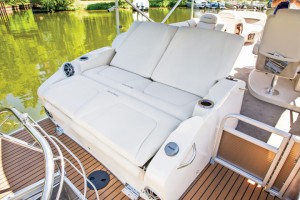
The traditional L-shaped seating arrangement is found on few pontoons today. Instead, builders are experimenting with a variety of arrangements on the stern of the boat, which contain both new seating and new features. The change has made a profound impact on the segment, according to Vogel.
“It is something fiberglass manufacturers have a hard time doing because they are contained with the hull,” he said. “Our platform can be tweaked and rearranged like a living room; the floor plans today have revolutionized the industry.”
Three years ago, Wachs said Godfrey released three different 22-foot pontoons with varying stern floor plans, all of which featured different variations of rear facing sofas, a double bed facing backwards and one had a bar with two bar stools. Within that time, they have become the top three selling models for the brand.
The trend has not changed today, according to Wachs, who believes the future of pontoons not only involve varying, rear-facing floor plans, but also features like galleys and changing rooms.
Jim Antolik, national sales manager for Premier Pontoons, said incorporating features into the stern has only grown, as customers have asked for more. The bar on Premier models is currently its most popular feature, and they have evolved from a small galley to full-service bars equipped with multiple bar stools, refrigerators, sinks and stemware storage. People also expect accommodations like portable toilets, changing rooms and even waterslides.
Such features are not offered in such lavishness in its entry-level models, but Antolik said it is features like the wet bar in its higher-priced products that have made them Premier’s most successful.
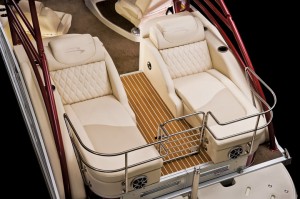
Antolik says pontoon owners are often unique compared to other boaters on a lake in that they expect to spend all day out on the water. It is the aforementioned features that make this possible.
“It is no longer just the evening cruise, it is an all-day event. And there are expectations the boat owner will have – everything it needs to spend the day,” he said.
The expectations for features may be universal, but not every prospective pontoon owner is the same. Therefore, pontoon builders have made a concerted effort to feature varying floor plans that ideally satisfy all.
 Wachs said Godfrey varies its floor plans not only for the new customer, but for the current pontoon owner who is looking for something different in his or her second purchase.
Wachs said Godfrey varies its floor plans not only for the new customer, but for the current pontoon owner who is looking for something different in his or her second purchase.
And the flat rectangle platform allows for this. Antolik said it is rare that Premier’s many predesigned layouts do not accommodate a buyer, but if so, the company also gives customers the opportunity to customize the floor plan to their needs.
“Looking at some of the other types of boats out there, you have to buy it a certain way, where now there is the opportunity for customers to lay out a floor plan the way they want it,” he said.
The untraditional pontoon
From the stitching on the furniture to the styling of the exterior, aesthetics are now top of mind for boat builders, as well as customers.
“It used to be where [customers] would walk onto the boat and ask about the horsepower on the back,” Wachs said. “Now, they will walk on [the boat], sit on and look at the furniture, and decide if they will continue to talk about it or not.”
When it comes to the highly competitive environment of boat shows, for example, it is the furniture and upholstery that drives interest in pontoon boats, according to Wachs. Contemporary-style furniture is required since people expect quality aesthetics similar to what they have in their living room.
Plush furniture like the pillow-top seating featured in many Bennington models or the triple-stitched upholstery often seen in Godfrey pontoons is a necessity for anyone outside of the bare bones, entry-level segment. For comfort, Premier fine tunes its seating with different innerspring suspensions and specialty foams.
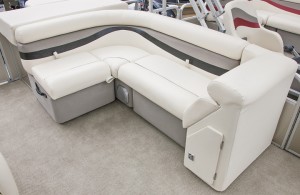
The exterior has long moved past the stigma of the pontoons of 20 years ago, as many exterior features add to the plush furniture and innovative features inside.
Streamlined and curved rail systems, along with curved Bimini top framework, are the norm on the outside of the boat. And the industry appears to be moving away from graphics on the exterior in favor of aluminum tubing.
Vogel said these features do require more materials and manufacturing time, making them upper-end model features; therefore, Bennington needs to adapt as requests for these luxuries come from customers of all models.
“You have to take a little out of the cost so you get 75 percent of the look, feel or function of something,” he said. “We want to give customers what they want, but do it in a way that is still differentiating our lineup.”
Wachs said sacrifices do need to be made in order to offer similar features on pontoons with lower price points. For Godfrey, comfort is not sacrificed, for example, but the seat boxes may not be as elaborate or the upholstery may not be as detailed. Carpet also may be the same color, but not as plush.
The segment’s success throughout the recovery has been predicated around providing value at all levels and not sacrificing that value for the entry-level customer – a crucial group of buyers for the industry’s success.
“A lot of the industry has left that price point, and is now starting to realize there is a lot of orphan customers out there,” Wachs said. “…We need to get the entry-level guy back in boating, and the pontoon industry has done a very good job of that over the last five years.”




